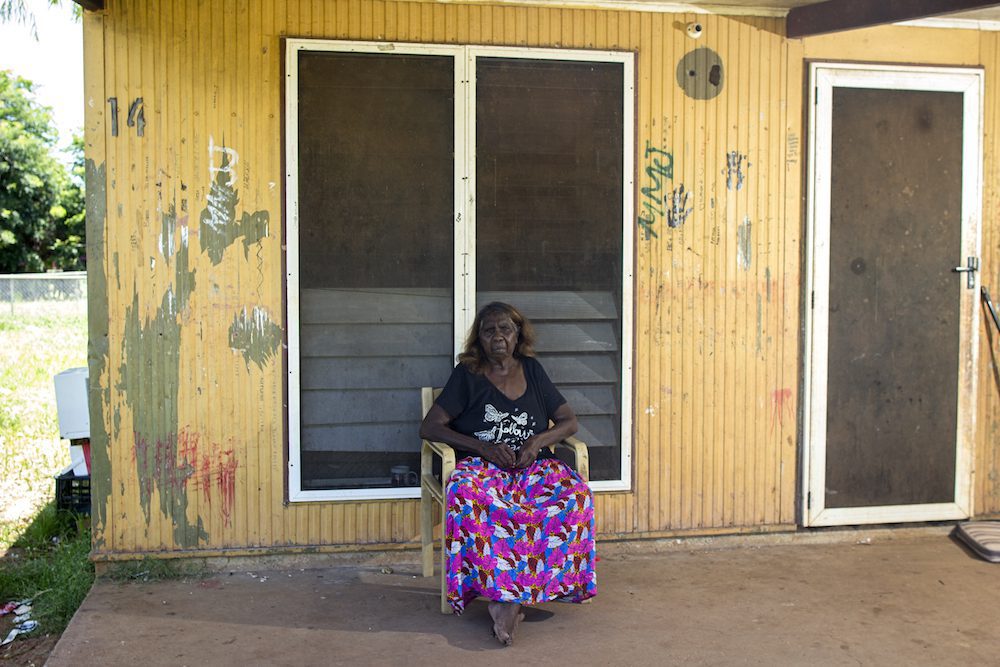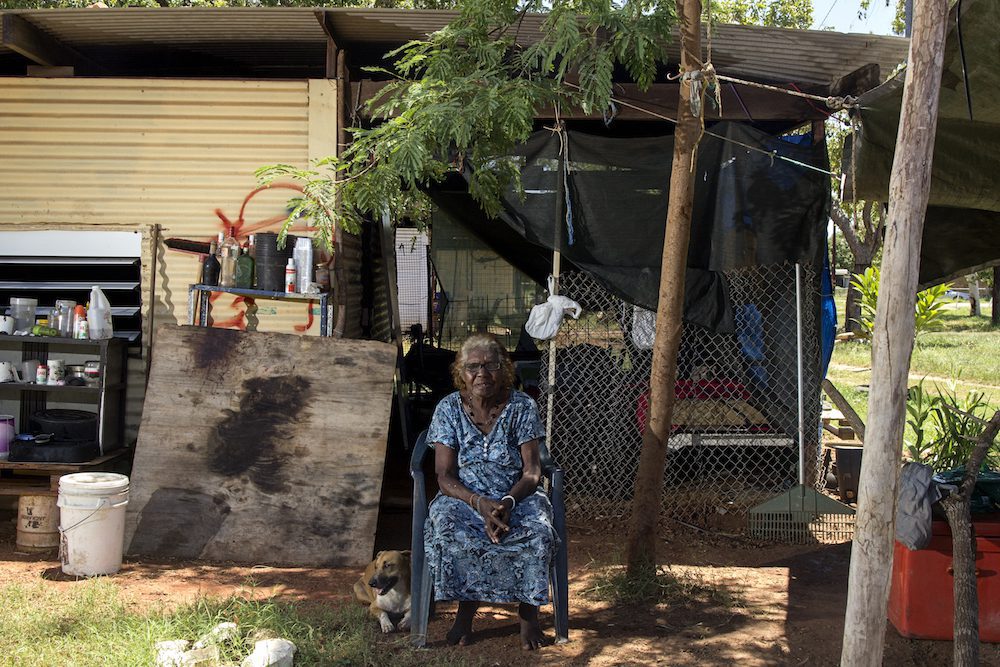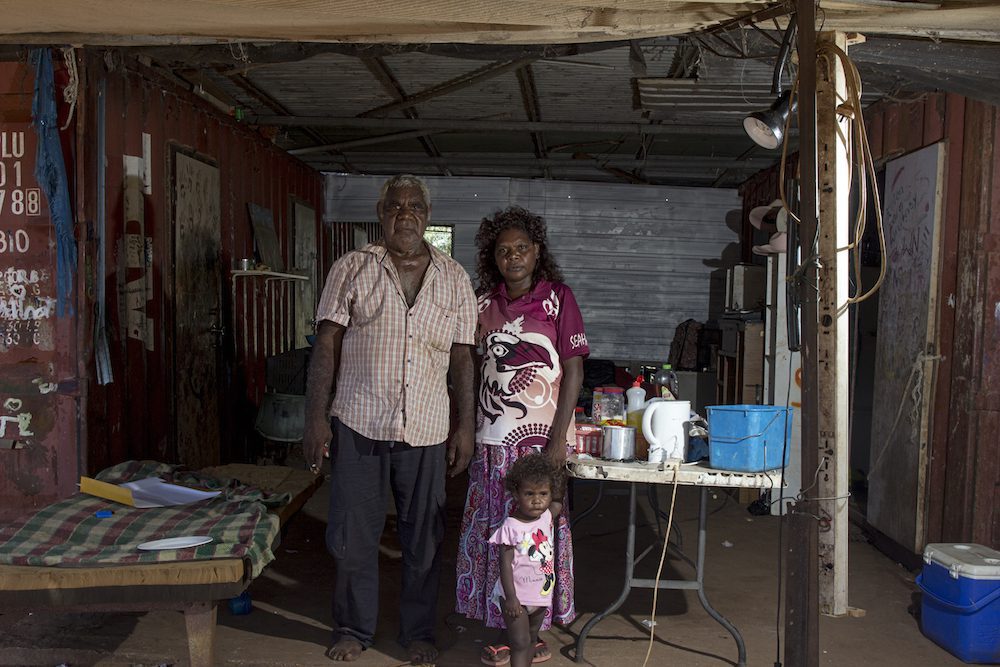Centre for
Contemporary
Photography
Current exhibition:
‘Auto-Photo: A Life in Portraits’, June 5 – Aug 16, 2025
RMIT Gallery, 344 Swanston St, Melbourne

Aboriginal and Torres Strait Islander viewers are advised that this website contains images and voice recordings of people who are deceased.
The main thing is… they should be talking very close to all those people that are involved in those camps. If those houses are allocated, seven houses to each camp, that’s the way those houses should be going. They shouldn’t be playing politics with Aboriginal people.
Garrwa, Gurdanji senior elder and cultural advisor Jack Green on the housing crisis in Borroloola, 2015.
This month Moving Images casts our eyes, ears and minds back to a critical and compelling series from the CCP archive: Garrwa, Yanyuwa artist Miriam Charlie’s My Country No Home. Charlie’s works, comprising documentary shots, portraits and voice recordings, were exhibited in CCP Declares: On the Social Contract between 27 May and 10 July 2016. CCP extends our thanks to the artist, those photographed and interviewed for the series, the family of Kathy Jupiter and Waralungku Arts Centre for their support.
My Country No Home focuses upon the members of Miriam Charlie’s community in Borroloola, Northern Territory. Home to about 1000 people, the town is situated along the banks of McArthur River roughly 700 kilometres south-east of Darwin. While Borroloola itself is on Yanyuwa country, residents also belong to the surrounding language groups of Garrwa, Marra and Gurdanji. Collectively their lands stretch north to the shores of the Gulf of Carpentaria, east to the Queensland border and south through the McArthur River Mine.
When Charlie created My Country No Home housing had long been an urgent issue in her town. Houses in camps surrounding the town centre, Garrwa Camp One, Garrwa Camp Two, Yanyuwa Camp and Mara Camp, were disintegrating, with some occupants left exposed to the elements and having to walk hundreds of metres for access to shared water and bathroom facilities. Like that of senior Yanyuwa woman Dinah Norman, many homes were constructed as accommodation in the aftermath of Cyclone Kathy in 1984. These structures weren’t built to last, they were a temporary solution to a temporary crisis. Although still standing some 32 years later, they were broken down and unliveable.

Charlie’s photography is sharp and strong, with vivid colours and carefully balanced compositions. Sitters are often placed at the perfect centre of their portraits, looking deep through the lens with clear, direct gazes. The portraits are matter-of-fact though far from cold. Charlie invites an almost neighbourly conversation with the viewer by presenting residents out the front of their properties. The images’ formal elements seem to forego much visual affect, but this deliberate choice of style serves to concentrates attention on the individuals and their stories. Charlie distils the images to their most striking and important parts.
From the interviews that accompany the photographs, it sounds like Charlie knows her sitters well. We catch details about their lives and personalities, a short yap from Kathy Jupiter’s dog or Dinah Norman’s sense of humour as she cracks that she’s been living in the one house for a long time, since ‘when I was a little bit young.’ Through the intimacy she holds with interviewees, Charlie draws out details about the houses and the community’s living conditions.

The power and persuasiveness of My Country No Home come from its combination of image and audio. Photographs present as documents of a place, time and experience. They show people within their family homes, but they also record doors, walls, roofs and floors that are deteriorating. In turn, interviews give personal insight into the frustration and difficulty of living in houses that are falling apart.
In Charlie’s own words, ‘the project is not to shame people, but to show the people how we’re living in Borroloola’. She challenges the potential for dodging, politicising and abstracting the issue — here are the people and here are their houses.

The history of funding for housing in Borroloola is lengthy. In 2009 the Federal Government allocated $14.6 million to the crisis, however this money had not been spent seven years later in 2016. In 2019 Special Envoy on Indigenous Affairs Tony Abbott launched a plan to install 12 decommissioned RAAF houses in the community, though it was subsequently abandoned.
The past year has seen 20 new homes built from both Federal and Territory funds, with plans for more across all four camps. Although Borroloola was temporarily locked down due to COVID-19, construction has now started again. New houses for Borroloola are a significant step forward, however, time spent waiting cannot be replaced. My Country No Home highlights the significant impact of the mismanagement of housing and its lived consequences.
In My Country No Home, we hear Jack Green’s assertion that the government needs to “stop playing politics with Aboriginal people.” Considering the needs of the community over the last 30 years, what explanation is there for Borroloola being left in limbo for so long?
CCP is passionate about connecting with our communities despite physical distance, and amplifying the work of lens-based practices in Australia. During 2019’s Government enforced closure, CCP presented a series of video works online via our website and social media platforms. The series, Moving Images, will highlight new and existing artworks, from emerging and established artists. Works will vary in length, format, and subject matter, but we hope they will be unified in their ability to keep you feeling connected and inspired, and bring our communities together while we are physically apart.
Notifications